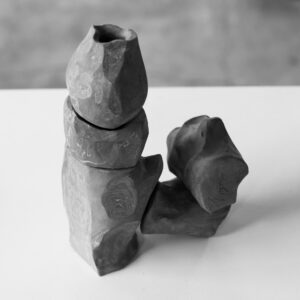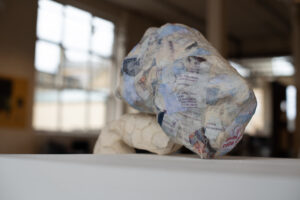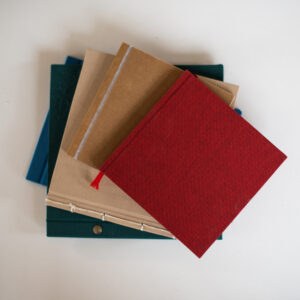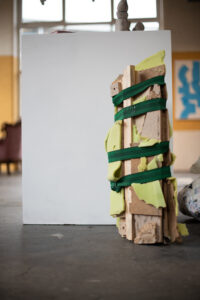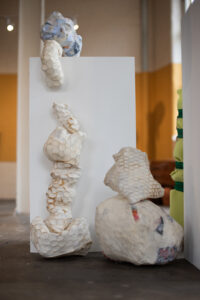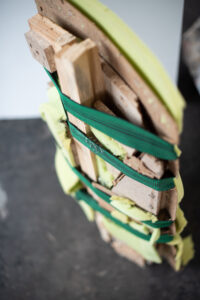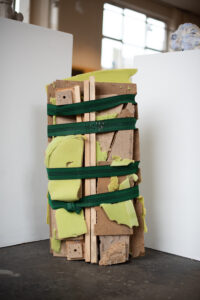YOUR FULL NAME, AND UNIVERSITY COURSE/YEAR.
Poppy Jones-Little, fourth year student at the University of Leeds. Website: www.poppyjoneslittle.wixsite.com/lumphood Instagram: @poppyjoneslittle Email: [email protected]
CAN YOU DESCRIBE YOUR WORK TO US IN 3 WORDS?
To describe my work in 3 words I would say, ‘intuitive, speculative and lumpen’.
WHAT MEDIUM DO YOU PREFER TO USE?
My work mainly utilises found objects or waste materials, with my treatment of material being innately sculptural. I am currently exploring how the research which fuels my making might become a more overt or transparent part of the work; I have started to re-appropriate and edit found texts. Moreover, photography is key to how I reflect upon my pieces and I have occasionally exhibited photographs of my lumps as the ‘work’.
WHAT IS THE INSPIRATION BEHIND YOUR WORK?
My ongoing research into ‘Lumphood’ is the crux of my practice. I encountered this term when reading Theodore Scaltsas’ account of Aristotle’s Theory of Substratum. Over the past five years I have been scouring various discourses which make use of the word ‘lump’. From Marx’s lumpenproletariat to Virginia Woolf’s short stories, from parenting books to Biblical teachings, from Essentialism to Oncology, a ‘lump’ transcends disciplines and ultimately refuses clarification and classification.
‘Lumps’ are not the same as ‘things’ or ‘objects’, nor can they be assimilated with ‘hunks’, ‘shards’ or ‘blobs’. A lump occupies a space somewhere within latency or excess, within the outer limits of our recognition. Often understood as an indiscriminate piece of matter, I have come to realise that this term can act as a placeholder. A word that is uttered when the right word cannot be recalled; ‘lump’ creeps in without clear intention to denote a non-thing. The ‘lumpenpack’, ‘lumpig’ and ‘lumpen’ within the German language all allude to the refuge and scraps, that which is wretched or worthless. These thoughts are central to any work I produce as they influence my treatment of a material. Yet, even before I began to pay conscious attention to ‘lump’, my practice has always involved working intuitively and sculpturally with material.
WHAT IS YOUR MOST IMPORTANT ARTIST TOOL? IS THERE SOMETHING YOU CAN’T LIVE WITHOUT IN YOUR STUDIO?
The tools I use when making range from pliers, hammers and screwdrivers, to cameras, books and the internet – frankly, due to working on instinct, I will use anything at hand!
DURING THIS UNCERTAIN TIME WHAT WILL YOU DO TO OCCUPY YOURSELF?
Within these uncertain circumstances I have been trying to consider how my largely sculptural practice might be able to adjust to a digital space – an issue which faces many others I am sure. A lump is typically considered to be such a tangible thing, usually something soft yet bulky, perhaps bodily or rounded; certainly when looking throughout art history there is a noticeable trend of what it means to work with ‘lumps’, and over the past few years I have realised that this idea of ‘lump’ is lazy and obvious – this wonderful little word encompasses so much more than meets the eye. And so, currently I have been considering how a lump might squeeze into the online. Questioning ‘how might lumps – now splintered – resurrect into pixels or algorithms?’ But aside from that – I’ve been doing a lot of gardening and hula-hooping!
Which current art world trend are you following?
I’ve become very conscious of how environmental concerns have become a prominent issue within artistic practice; certainly given the current climate crisis and ecological emergency, I have increasingly been working with waste or found materials. This consciousness prompts me to avoid purchasing synthetic substances which easily lend themselves to obvious ‘lumpy’ forms. Navigating this awareness and its limitations has forced my work to shift, compelling me to consider ways of ‘making’ which are not detrimental to our environment.
Plans for the future?
Given the uncertainly at present I am finding it tricky to think beyond my degree. However, once graduated I have always intended to have a year out of education and work in order to save enough money to afford an MA; I would love to continue studying an art-related course at a higher level – I’m not finished with lumps quite yet!
It would be great if, through my research specialism of ‘lumps’, I could somehow encourage others to tease apart everyday language and to consider the implications of words we may not pay the slightest attention to. In a world where it is so easy to lump people together based upon fictitious categories, I believe it is important to encourage deeper consideration.
Any books/ films/tv series that you’d recommend for anyone interested in art?
In terms of art-related books, films or tv series I’m reminded of ‘Abstract: The Art of Design’ series, the classic ‘Antiques Roadshow’, or the ‘The Great Pottery Throw Down’ on Channel 4, movies such as ‘Velvet Buzzsaw’ or any of the hundreds of artist biopics, and I wouldn’t know where to begin with recommending books!
Nonetheless, within my own research practice, I find that points of interest can be found when not expected; for example, I was re-reading Marge Piercy’s ‘Woman on the Edge of Time’ and found ‘lump’ to be utilised in such interesting ways, and even when watching the BBC’s ‘The Last Tango in Halifax’, one character exclaimed, ‘he is a muck lump just like his mother!’. I think the brilliant thing about having a creative practice is that there isn’t a didactic or prescribed means of acquiring knowledge – anything and everything can be of use, and being open to this is key.
What are your favourite Instagram accounts?
Instagram is such a great space for encountering artists, yet as a student, I think it’s good practice to always research a little deeper (checking out artist websites, online articles, books etc) once you have found something of interest. To name a few of my favourite accounts, @materialdriven is a design agency that develops innovative sustainable materials, @lumpstudio is a pottery studio in Wong Chuk Hang and @elephantmagazine is a visual culture magazine (both online and print).
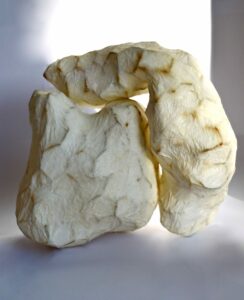
What is your most successful piece of work and why?
I have absolutely no idea which of my lumps I would class as my most successful piece of work; I find it so tricky to consider my practice in this way as everything is always in constant flux! I think I struggle with the idea of ‘successful’ as throughout my education this has often meant jumping through the right hoops, ticking the right boxes, knowing exactly what needs to be said and how to say it. The beautiful thing about my focus upon ‘lump’ is that it just keeps giving, it is this wonderfully complex thing, sticky and crunchy and difficult. Can a lump ever be successful?
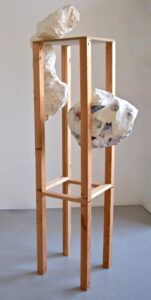
Find out more about the artists in Ones to Watch here.
Back To Blog Next (Ones to Watch: Interview with T’Shah Henry) Prev (Artist Interview: Sophia Reeson)Tags
General Arts & Culture

